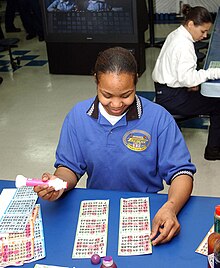Bingo (US)
 |
|
| Years active | 1920s- (modern American bingo) |
|---|---|
| Random chance | a lot |
In the United States, Bingo is a game of chance in which each player matches numbers pre-printed in different arrangements on 5×5 cards with the numbers the game host draws at random, marking the selected numbers with tiles. When a player finds the selected numbers are arranged on their card in a row, they call out "Bingo!" to alert all participants to a winning card, which prompts the game host (or an associate assisting the host) to examine the card for verification of the win. Players compete against one another to be the first to have a winning arrangement for the prize or jackpot. After a winner is declared, the players clear their number cards of the tiles and the game host begins a new round of play.
Alternative methods of play try to increase participation by creating excitement. Since its invention in 1929, modern bingo has evolved into multiple variations, with each jurisdiction's gambling laws regulating how the game is played. There are also nearly unlimited patterns that may be specified for play. Some games require only one number to be matched, while cover-all games award the jackpot for covering an entire card. There are even games that award prizes to players for matching no numbers or achieving no pattern. See "Variations" for more details.
The most common Bingo cards are flat pieces of cardboard or disposable paper which contain 25 squares arranged in five vertical columns and five side to side rows. Each space in the grid contains a number.
A typical Bingo game utilizes the numbers 1 through 75. The five columns of the card are labeled 'B', 'I', 'N', 'G', and 'O' from left to right. The center space is usually marked "Free" or "Free Space", and is considered automatically filled. The range of printed numbers that can appear on the card is normally restricted by column, with the 'B' column only containing numbers between 1 and 15 inclusive, the 'I' column containing only 16 through 30, 'N' containing 31 through 45, 'G' containing 46 through 60, and 'O' containing 61 through 75.
The number of all possible Bingo cards with these standard features is P(15,5) × P(15,5) × P(15,5) × P(15,5) × P(15,4) = 552,446,474,061,128,648,601,600,000 or approximately 5.52×1026.
In U-Pick 'Em bingo and other variants of bingo, players are issued three 25 number cards which contain all 75 numbers that may be drawn. Players then mark which numbers they wish to play and then daub those numbers according to the numbers drawn. In addition, double-action cards have two numbers in each square.
A player wins by completing a row, column, or diagonal. The most chips one can place on a Bingo board without having a Bingo is 19, not counting the free space. In order for this to happen, only one empty cell can reside in each row and each column, and at least one empty cell must be in each diagonal, for instance:
...
Wikipedia
